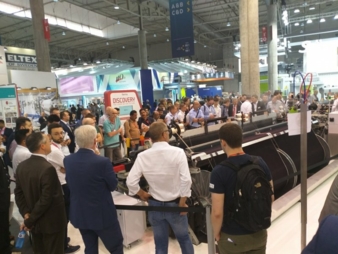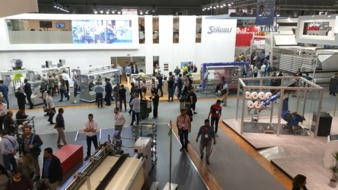02/08/2019 – New weft insertion method pulls the crowds — auf Deutsch lesen
ITMA: Innovation meets traditional weaving
From 20 to 26 July 2019, Barcelona hosted ITMA 2019, opening the stage to innovative and forward-looking concepts in textile machine engineering.
Filling an exhibition area of 114,500 sqm, ITMA 2019 had once again expanded by 9 percent against the previous fair in Milan. The 105,000 visitors from 137 countries demonstrated that the leading fair for textile machine engineering is far from being an endangered species. In the weaving section, 182 companies unveiled their latest technologies. They were delighted with the high levels of footfall from the first to the last day of the event.
A big surprise
Visitors who went to ITMA 2019 expecting that weaving would be fully focused on the topic of Industry 4.0, were definitely in for a surprise. A new shuttle-less weft insertion system, developed by the Italian ITEMA Group, stole the show from the many new ideas related to Industry 4.0., and the “flying shuttle” was not the only noteworthy mechatronic innovation. The Smart Creel from van de Wiele Group has the potential to at least partially replace the warp beam in the future. Similarly, Stäubli produced 3D woven garments on a Jacquard machine, in much the same way as the flat-knitting machines. This development could lead to the demise of sewing machines in some settings. Innovations such as these pushed the fair’s headline theme, the digitalisation of textile machines, well into the background. Some visitors will have sighed with relief, no doubt. Not least because not everything on show in this area was all that convincing.
European manufacturers – quo vadis?
Takeovers and the associated depletion of exhibition space booked by European manufacturers have been shaping preparations for ITMA in recent years. The latest example was the acquisition of SSM Textilmaschinen by Rieter Konzern, whose stand featured the SSM package winding technology. SSM premiered “Preciforce”, a new back-pressure system, which can already operate at forces of 200g, producing extremely soft packages.
Proactive Warping from Karl Mayer represents an interesting approach to cloud-based Quality Management. When the customer uploads its warp beam production data to the company’s Cloud, the experts at Karl Mayer create evaluations and QM protocols which are returned to the customer with suggestions on how to make improvements for the next warp beam. If the current prototype trials prove successful, it will result in an ‘expert’ warping frame with a continuous, quality-centric learning capability.
The question of whether weaving looms will still require warp beams in the future was raised by van de Wiele and its Smart Creel. Concentrated in the smallest of spaces, each creel module holds 1,600 warp threads which are fed to the loom using new, individual tension control technology. While the loom is operating, one or several robots continuously wind up to 1,300 m of thread onto the winding heads of each module. In this way, even the smallest sample sizes can be woven fully automatically. The concept was originally borrowed from the modern Axminster machine, which was presented by van de Wiele in Munich in 2007. The further development was initially applied to velvet and carpet weaving looms and subsequently, for the first time, to looms for flat woven cloth. The test phase for this concept will reveal whether and for what kind of applications the production of warp beams will be rendered superfluous.
Weft insertion system from ITEMA steals the show
The new shuttle-less weft insertion system from the ITEMA Group was without doubt the biggest attraction at the weaving exhibition. The “Discovery”, a bright red loom, revealed (just) twice a day a flying rapier head with a positive weft transfer system. Not surprisingly, the astounded visitors flocking to the machine struggled to see much detail as the “flying shuttle” shot across the 400cm-wide loom, 350 times per minute. This development started to germinate just four years ago, after ITMA 2015 in Milan. The process is reminiscent of the projectile weft insertion system: A servomotor accelerates the rapier head, as it is guided through the shed, before it is caught on the right-hand side and transported back again, allowing seven such projectiles to work in a cycle.
Christian Straubhaar, Marketing Director of the ITEMA Group:
“The programmable acceleration resembles a knock by a billiard ball which inserts the 40cm long shuttle in an energy-saving manner. This makes it possible to weave denim to the same high quality achieved on a projectile loom but at a considerably lower cost.”
Although the company sees the application of this new technology chiefly in the production of denim, the flexibility of the thread take-up by the rapiers and the individual adjustability of the acceleration leave plenty of room for other applications. The machine looks set to go on sale in two to three years’ time. And, of course, the aim is to increase the speed to more than 400 rev/min. The slight terminological confusion caused by a shuttle-less insertion method being described as the “flying shuttle” merits no more than a quick mention.
Minimise selvedge waste
Loom manufacturers have attempted rather unsatisfactorily to minimise selvedge waste in the past. At this year’s ITMA, this issue was once again tackled by many exhibitors. A great example here is the Dornier Weft Saver (DWS) from Dornier. Precise thread clamps collect the weft thread at the scissors, whilst it is being pulled back to the roving package with Pulsar. Savings of up to 6 to 10 cm are possible on a machine width of 2.2 m, says Dornier.
The use of servomotors for shedding represents a major step towards the digitalisation of weaving looms. Until now, looms for technical textiles and Toyota with its e-shedding were the only ones available. At ITMA, Picanol demonstrated this kind of shedding on several machines. Picanol’s main priority has been to replace the previously mechanical setting of the shedding device with a digitalised alternative. As long as the number of shafts is limited, the energy consumption of the servomotors is said to be not much higher than that of a conventional dobby machine.
loT – the Internet of Things
The weaving industry has spent a lot of time exploring the possibilities of the Internet of Things (IoT), digitalisation and cloud-based control. What was striking at ITMA was the reserve and reticence with which the results were presented to visitors. The many online concepts with which machines are monitored, maintained or improved in terms of product quality, were in many cases no more than proposals serving as a basis for discussion with customers. A particularly critical problem is the use and storage of product-specific customer data. The visitors are unlikely to have been surprised by this issue, as we are all familiar with the highly questionable safety of our data in other areas of the internet. The lasting impression of the fair was that loom engineering is currently advancing more through creative engineering ideas than through the internet and new media.
By Prof Dr Alexander Büsgen
Hochschule Niederrhein, University of Applied Sciences
Faculty of Textile and Clothing Technology





